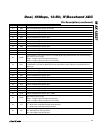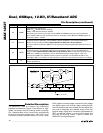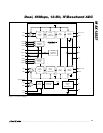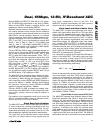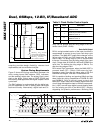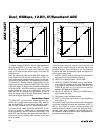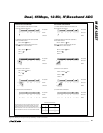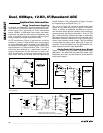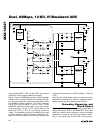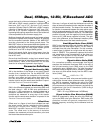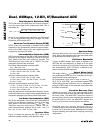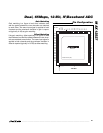
mount devices for minimum inductance. Bypass V
DD
to
GND with a 220µF ceramic capacitor in parallel with at
least one 10µF, one 4.7µF, and one 0.1µF ceramic
capacitor. Bypass OV
DD
to GND with a 220µF ceramic
capacitor in parallel with at least one 10µF, one 4.7µF,
and one 0.1µF ceramic capacitor. High-frequency
bypassing/decoupling capacitors should be located as
close as possible to the converter supply pins.
Multilayer boards with ample ground and power planes
produce the highest level of signal integrity. All grounds
and the exposed backside paddle of the MAX12527
must be connected to the same ground plane. The
MAX12527 relies on the exposed backside paddle con-
nection for a low-inductance ground connection. Isolate
the ground plane from any noisy digital system ground
planes such as a DSP or output buffer ground.
Route high-speed digital signal traces away from the
sensitive analog traces. Keep all signal lines short and
free of 90° turns.
Ensure that the differential, analog input network layout
is symmetric and that all parasitic components are bal-
anced equally. Refer to the MAX12557 EV kit data
sheet for an example of symmetric input layout.
Parameter Definitions
Integral Nonlinearity (INL)
INL is the deviation of the values on an actual transfer
function from a straight line. For the MAX12527, this
straight line is between the endpoints of the transfer
function, once offset and gain errors have been nulli-
fied. INL deviations are measured at every step of the
transfer function and the worst-case deviation is report-
ed in the Electrical Characteristics table.
Differential Nonlinearity (DNL)
DNL is the difference between an actual step width and
the ideal value of 1 LSB. A DNL error specification of
less than 1 LSB guarantees no missing codes and a
monotonic transfer function. For the MAX12527, DNL
deviations are measured at every step of the transfer
function and the worst-case deviation is reported in the
Electrical Characteristics table.
Offset Error
Offset error is a figure of merit that indicates how well
the actual transfer function matches the ideal transfer
function at a single point. Ideally, the midscale
MAX12527 transition occurs at 0.5 LSB above mid-
scale. The offset error is the amount of deviation
between the measured midscale transition point and
the ideal midscale transition point.
Gain Error
Gain error is a figure of merit that indicates how well the
slope of the actual transfer function matches the slope of
the ideal transfer function. The slope of the actual trans-
fer function is measured between two data points: posi-
tive full scale and negative full scale. Ideally, the positive
full-scale MAX12527 transition occurs at 1.5 LSBs below
positive full scale, and the negative full-scale transition
occurs at 0.5 LSB above negative full scale. The gain
error is the difference of the measured transition points
minus the difference of the ideal transition points.
Small-Signal Noise Floor (SSNF)
SSNF is the integrated noise and distortion power in the
Nyquist band for small-signal inputs. The DC offset is
excluded from this noise calculation. For this converter,
a small signal is defined as a single tone with an ampli-
tude of -35dBFS. This parameter captures the thermal
and quantization noise characteristics of the data con-
verter and can be used to help calculate the overall
noise figure of a digital receiver signal path.
Signal-to-Noise Ratio (SNR)
For a waveform perfectly reconstructed from digital
samples, the theoretical maximum SNR is the ratio of
the full-scale analog input (RMS value) to the RMS
quantization error (residual error). The ideal, theoretical
minimum analog-to-digital noise is caused by quantiza-
tion error only and results directly from the ADC’s reso-
lution (N bits):
SNR
[max]
= 6.02 × N + 1.76
In reality, there are other noise sources besides quanti-
zation noise: thermal noise, reference noise, clock jitter,
etc. SNR is computed by taking the ratio of the RMS
signal to the RMS noise. RMS noise includes all spec-
tral components to the Nyquist frequency excluding the
fundamental, the first six harmonics (HD2 through
HD7), and the DC offset.
SNR = 20 x log (SIGNAL
RMS
/ NOISE
RMS
)
Signal-to-Noise Plus Distortion (SINAD)
SINAD is computed by taking the ratio of the RMS sig-
nal to the RMS noise plus distortion. RMS noise plus
distortion includes all spectral components to the
Nyquist frequency excluding the fundamental and the
DC offset.
MAX12527
Dual, 65Msps, 12-Bit, IF/Baseband ADC
______________________________________________________________________________________ 25



